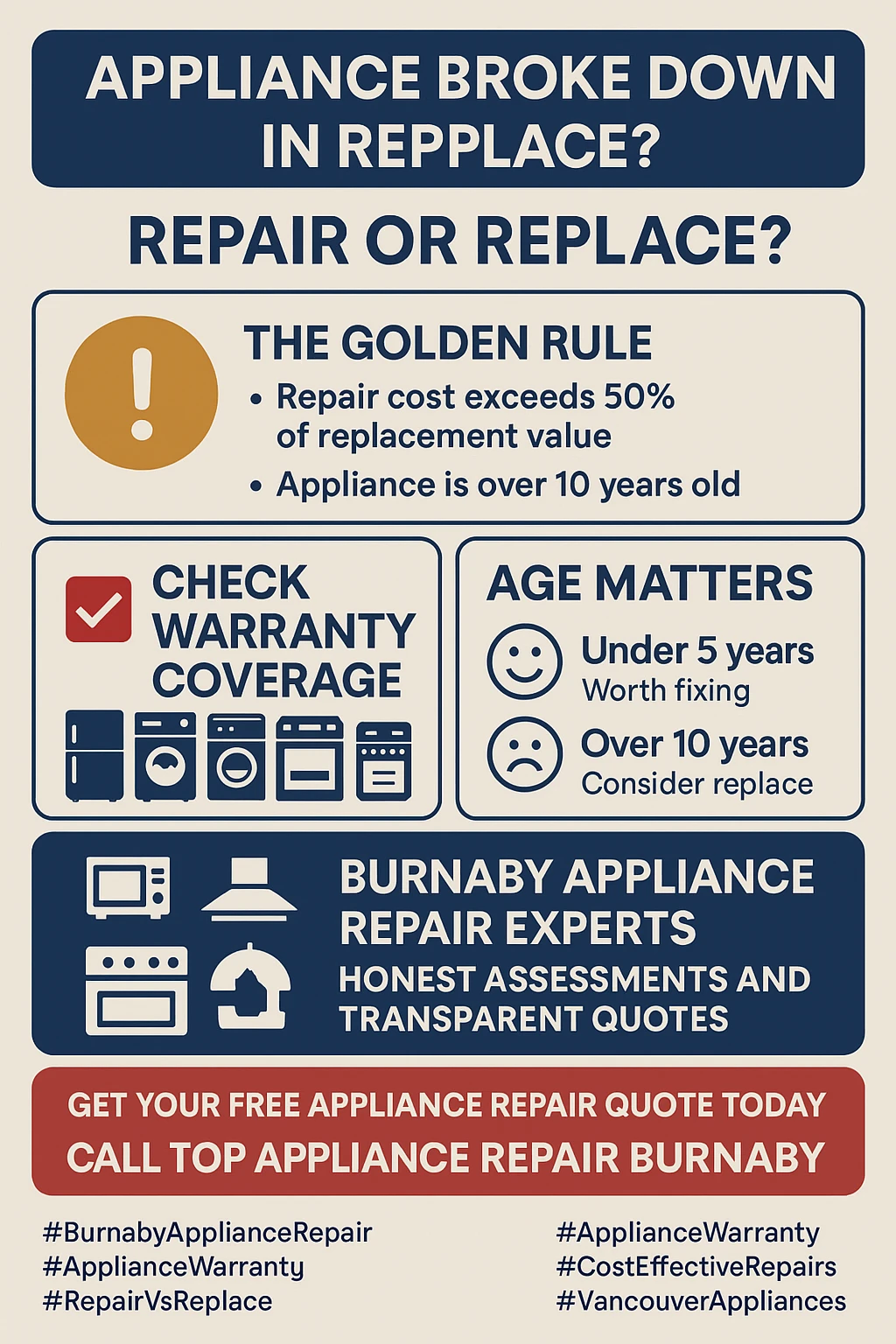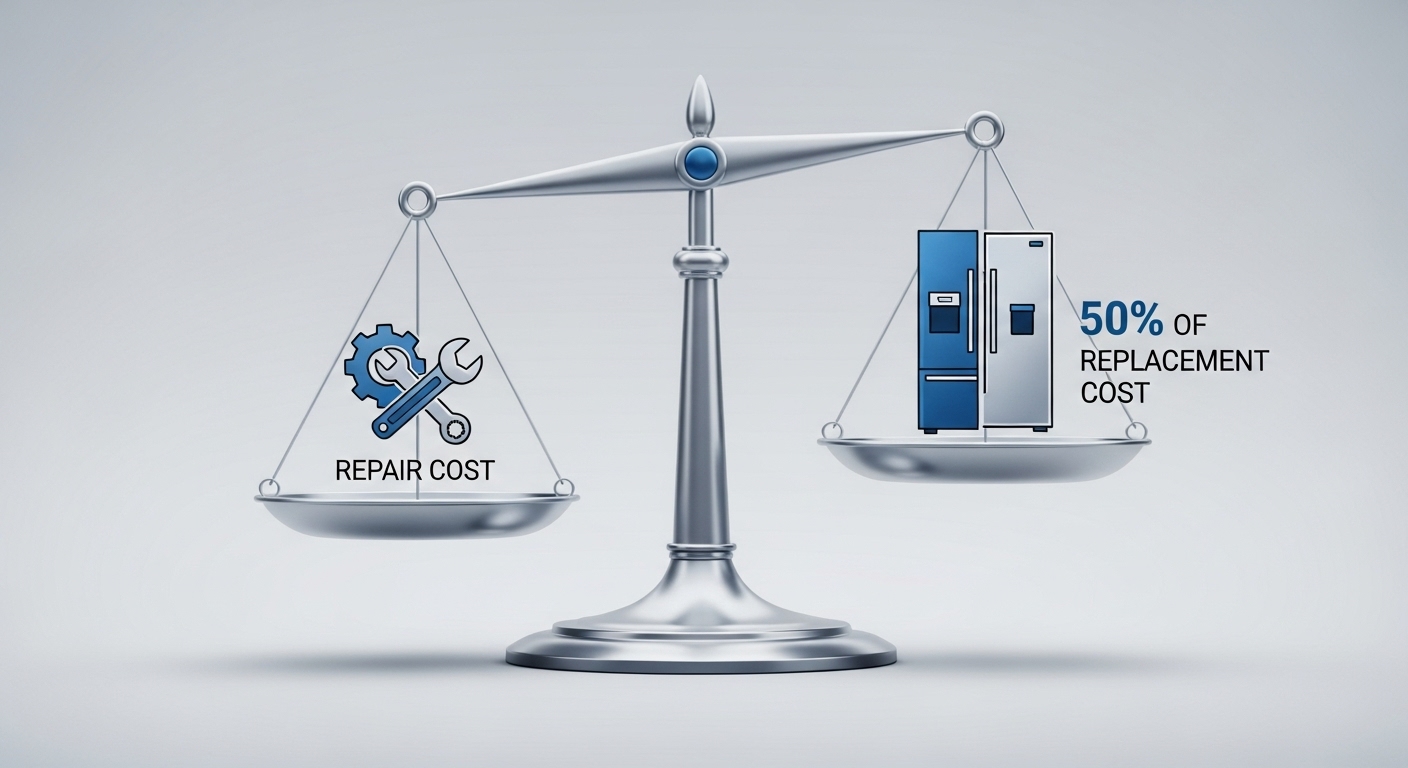Appliance Warranty vs Repair Cost: When to Fix or Replace Your Broken Appliance in Burnaby
Struggling to decide whether that sputtering dishwasher or temperamental washing machine deserves another chance? You’re not alone – homeowners across Burnaby face this costly dilemma every day, and making the wrong choice can cost you hundreds or even thousands of dollars.
When your appliances start acting up, the decision between repair and replacement becomes a critical financial choice that requires careful consideration of multiple factors. The age of your appliance, current repair costs, warranty coverage, and replacement expenses all play crucial roles in determining the most cost-effective path forward. For Burnaby residents, additional factors like the coastal climate’s impact on appliance longevity and local repair market conditions add another layer of complexity to this important decision.

Understanding the relationship between appliance warranties and repair costs empowers you to make informed choices that protect both your budget and your home’s functionality. Whether you’re dealing with a minor malfunction or a major breakdown, having a clear framework for evaluating your options can save you significant money while ensuring your household runs smoothly. The key lies in knowing when warranty coverage provides genuine value versus when direct repair payments or outright replacement make more financial sense.
This comprehensive analysis will examine the critical factors Burnaby homeowners need to consider when facing appliance breakdowns, including local repair costs, warranty options, and the unique environmental challenges that affect appliance performance in our coastal region. By understanding these elements, you’ll be equipped to make confident decisions that maximize value while minimizing unexpected expenses.
Key Outtakes:
- Follow the 50% rule: if repair costs exceed half the replacement price, consider replacing the appliance rather than investing in costly repairs
- Vancouver’s coastal climate accelerates appliance wear due to salt air and humidity, making regular maintenance crucial for extending lifespan
- Home warranties cost $500-600 annually but may not cover all repair scenarios compared to manufacturer warranties that focus on specific defects
- Local Burnaby repair services typically charge $195-500 per repair, making thorough cost analysis essential before proceeding
- Appliances under 8-10 years old with good maintenance records are usually worth repairing, while older units may warrant replacement

Understanding Appliance Warranties vs Direct Repair Costs
The first step in making smart appliance repair decisions involves understanding the different types of coverage available and how they compare to paying for repairs directly. Manufacturer warranties typically provide coverage for one to five years and focus specifically on defects in materials or workmanship, offering the most comprehensive protection during an appliance’s early years. These warranties usually cover both parts and labor costs, making them the most valuable form of protection when applicable to your situation.

Extended warranties present another option by adding two to four years of coverage beyond the manufacturer’s original warranty period. While these plans require additional upfront investment, they can provide peace of mind for expensive appliances that may experience costly component failures after the initial warranty expires. However, extended warranties often come with restrictions on coverage and may not include the same level of comprehensive protection as manufacturer warranties.
Home warranties offer a different approach by providing bundled coverage for multiple appliances and home systems. These plans typically cost between $500 and $600 annually, plus service fees of $60 to $100 for each repair call. While this coverage can protect against unexpected expenses across multiple appliances, the service fees and potential limitations on repair quality make it important to carefully evaluate whether this investment provides genuine value for your specific situation.
Direct repair costs in the Burnaby market vary significantly based on the type of appliance and the complexity of the required work. Local repair services typically charge diagnostic fees of $139 to $179, though these fees are usually waived if you proceed with the recommended repairs. Understanding these baseline costs helps you evaluate whether warranty coverage or direct payment provides better value for your specific repair needs.
The hidden costs associated with appliance replacement often make repair more attractive than initially apparent. Replacement involves installation fees ranging from $100 to $500, delivery charges of $50 to $100, and disposal fees of $75 to $150 for your old appliance. These additional expenses can add $300 to $600 to the total cost of replacement, making repairs more cost-effective even when the appliance itself costs less than expected.
The 50% Rule and Smart Decision-Making Framework
The widely recognized 50% rule provides a reliable starting point for repair versus replacement decisions across all appliance categories. This guideline suggests that if repair costs exceed 50% of the replacement cost for an equivalent appliance, replacement typically offers better long-term value. The calculation is straightforward: divide the estimated repair cost by the replacement cost, and if the result exceeds 0.5, replacement generally makes more financial sense than investing in repairs.

However, this rule requires careful application of all relevant costs to provide accurate guidance. The replacement cost should include not just the appliance price but also installation, delivery, and disposal fees that can add hundreds of dollars to the total expense. Similarly, repair costs should account for diagnostic fees, parts costs, labor charges, and any additional service calls that might be required if the initial repair doesn’t resolve all issues.
Several situations warrant deviation from the standard 50% rule, particularly when dealing with high-end appliances or special circumstances. Premium appliances with superior build quality may justify repair costs exceeding 50% of replacement value because they offer better performance and longer expected lifespans than basic replacement units. Additionally, appliances still under warranty should generally be repaired regardless of cost, as warranty coverage eliminates the financial risk associated with the repair investment.
Age plays a crucial role in applying the 50% rule effectively, as newer appliances typically warrant repair while older units may be better candidates for replacement. Refrigerators typically last 10 to 15 years, washing machines 8 to 12 years, and dishwashers 9 to 10 years, making age relative to expected lifespan an important factor in repair decisions. An appliance that has reached 80% of its expected lifespan may warrant replacement even if repair costs fall below the 50% threshold.
Safety considerations can override cost-based decision-making when appliances pose potential hazards to your household. Gas appliances with suspected leaks, electrical appliances showing signs of short circuits or overheating, and any appliance producing unusual smoke, sparks, or burning smells require immediate replacement regardless of repair costs. These safety concerns take precedence over financial calculations and warrant immediate professional evaluation.
Appliance-Specific Lifespan and Repair Considerations
Different appliances have unique characteristics that affect repair versus replacement decisions, making it important to understand the specific factors relevant to each type of equipment in your home. Dishwashers typically require replacement every 10 years, with common problems including rust formation, persistent standing water, and door latch failures that indicate the unit is nearing the end of its useful life. When dishwashers begin experiencing multiple issues simultaneously, replacement often provides better value than attempting to address each problem individually through separate repairs.
Garbage disposals present a clear case for replacement over repair in most situations, as these appliances typically need replacement every 8 to 12 years and repairs rarely provide long-term solutions. Signs indicating replacement necessity include frequent jamming, unusual grinding noises, persistent odors, and water leaks from the unit housing. The relatively low cost of replacement units compared to repair expenses makes replacement the preferred option for most disposal problems.
Microwave ovens have the shortest expected lifespan among major appliances, typically lasting only five years maximum before requiring replacement. Signs like smoke, sparks, or burning smells indicate immediate replacement needs, as these symptoms suggest dangerous electrical problems that cannot be safely repaired. The low cost of replacement microwaves compared to repair expenses makes replacement the standard recommendation for most microwave problems.
Major appliances like refrigerators and washing machines warrant more careful analysis due to their higher replacement costs and longer expected lifespans. Refrigerators can justify significant repair investments when they’re under 10 years old and experiencing isolated component failures, particularly for high-end models with advanced features. However,